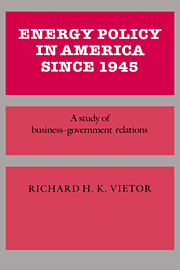Book contents
- Frontmatter
- Contents
- List of charts and figures
- List of tables
- Editors' preface
- Acknowledgments
- List of abbreviations
- 1 Introduction: The political economy of energy
- Part I The transition to peace and fluid fuels, 1945–1958
- 2 The foundations of postwar policy
- 3 “Stepping right out” with synthetic fuels
- 4 Regulating natural gas in the absence of economics
- 5 Oil imports: the failure of voluntarism
- Part II Managing surplus through the politics of stasis, 1959–1968
- Part III The second energy transition: adjustment to depletion, 1969–1980
- Index
3 - “Stepping right out” with synthetic fuels
Published online by Cambridge University Press: 13 October 2009
- Frontmatter
- Contents
- List of charts and figures
- List of tables
- Editors' preface
- Acknowledgments
- List of abbreviations
- 1 Introduction: The political economy of energy
- Part I The transition to peace and fluid fuels, 1945–1958
- 2 The foundations of postwar policy
- 3 “Stepping right out” with synthetic fuels
- 4 Regulating natural gas in the absence of economics
- 5 Oil imports: the failure of voluntarism
- Part II Managing surplus through the politics of stasis, 1959–1968
- Part III The second energy transition: adjustment to depletion, 1969–1980
- Index
Summary
In 1980, when Iranian oil exports were shut down by revolution and OPEC oil prices were doubling again, Congress created a Synthetic Fuels Corporation. This “independent federal entity” was authorized to spend $88 billion to facilitate development of a commercial synthetic fuels industry by 1992. Major oil and gas companies expanded their research and development programs and planned a score of huge projects to liquefy and gasify coal and to produce oil from shale.
A push of the same sort, more than three decades earlier, had all but faded from the nation's memory. In 1948, the New York Times had reported that “the United States is on the threshold of a profound chemical revolution. The next ten years will see the rise of a massive new industry which will free us from dependence on foreign sources of oil. Gasoline will be produced from coal, air and water.” During World War II, the federal government had begun a program to develop synthetic fuels, and the Truman administration considered them to be nearly commercially feasible. How and why that program came into being – and then was abandoned – tell something about the making of public policy in the United States.
In the judgment of John O'Leary, an experienced energy bureaucrat, the effort was abandoned “when the Eisenhower administration came into office, largely because of the representations of the petroleum industry.”
- Type
- Chapter
- Information
- Energy Policy in America since 1945A Study of Business-Government Relations, pp. 44 - 63Publisher: Cambridge University PressPrint publication year: 1984



